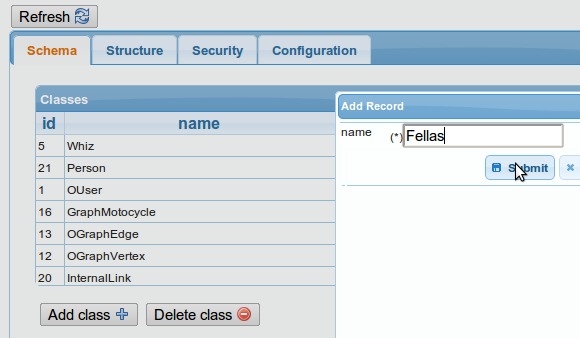As I said, Orient has an HTTP interface which you can use to manage and query any DB, document and navigate the graph: since it speaks HTTP…
OrientDB and PHP
So, as you can imagine, liking OrientDB and HTTP brought me and David writing the PHP binding for Orient DB: it is a small library ( a couple classes, a couple interfaces ) able to let you manage your database through HTTP and an OO API.
We’re still working on it, but it’s already usable.
As I’ll show you now, graph in php can be really funny and simple.
Friendship traversal in 5 minutes
You have this new super-cocky website which lets the user be friends, share stuff and so on. Just like FaceBook.
So you download orient, start the server and go to 127.0.0.1:2480, where you can administrate your Orient server via web, through OrientStudio.
Orient’s package comes with a demo DB, so you only need to log in as admin/admin.
Set-up instructions are doable also with PHP, but I think, to be faster and more clear, we should use OrientStudio instead.

So, now, you only need to create a class, called fellas.
A class is similar to a real-world class, like in OO design: so records of the same class share the type and class propertis ( when mandatory: as I said yesterday, classes can be schema-full, -less, -mixed ).
As you create the class you should populate it with some records, from the command tab:
1 2 3 4 5 | |
Note that you’ll need to execute insert after insert, as multiple inserts are not supported.
After you created your records you are able to see them: go to the query tab and execute
1
| |

So you see your records with some attributes:
@rid, the resource identifier of your record: the part before the colon is the ID of the cluster ( a cluster is like a table, gruping all the records of the same class ), the second the ID of the record@versionis the …well you guessed it: it’s auto-magically handled by Orient when you create/update your records@classname, which is the property assigned with the INSERT command: remember it has been created on-the fly ( schema-less )
Now we just want to connect our fellas:

As you can see, the graph is undirected, with no cycles1.
So we have to update our records:
1 2 3 4 5 6 | |
There we go:

Now, to work with this grah with php, just clone the binding from GitHub; your directory structure should look like:
1 2 3 4 5 | |
where myProject is your project route and fellas.php the script we want to execute to retrieve Michelle Obama’s connections.
First of all we should register an autoloading function in fellas.php2:
1 2 3 4 5 6 7 8 9 10 11 | |
then we need to istantiate the HTTP client for Orient and the binding:
1 2 3 4 | |
after that we can execute our query:
1 2 3 | |
and output the results:
1 2 3 4 5 6 7 | |

As you will see ( try running the script from the command line or from your localhost ) the output will return all Michelle Obama’s connection, direct and indirect.
If we modify the query we can return all the connections under a certain depth ( which is determined by the traverse() arguments ).
So, in 5 minutes, you should be able to setup and work with a graph DB from PHP.
Under the hood
When you work with an instance of Binding almost every public method returns an HTTP Response, so you basically only need to get the body of the response and json_decode() it ( OrientDB works only with the JSON format ).
Once you decoded it, you can parse it as a Std object: if you’re not ok working with this kinda stuff don’t worry, because…
Object graph mapper and… Help!
Our library is quite finished: we still need to define better interfaces and polish a few things, but the main functionalities are there, ready to be used.
As soon as we release the first stable version we will start working on a basic mapper ( OGM sounds cool ) for OrientDB: if you want to help us, don’t hesitate, we will certainly need the help of someone from PHP’s community.